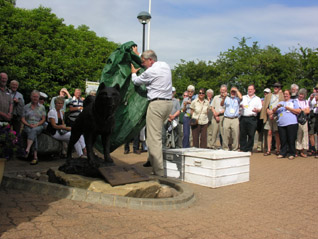The memorial to the husky sledge dog commemorates the vital contribution of dog teams to Antarctic field travel and morale from 1945 to 1994. The life-size bronze statue by sculptor David Cemmick of the Cemmick & Wylder Studio in Lancashire is mounted on a plinth of York sandstone with a bronze plaque in front, also mounted on a York sandstone block. The plaque lists all the FIDS/BAS husky dog team names with an inscription ‘Erected by their companions and friends 2009’. It was originally positioned at the front door of the BAS Cambridge building and unveiled on 4 July 2009, during a BAS Club reunion visit. In 2015 it was removed due to new building work and now stands outside the main entrance to the Scott Polar Research Institute, Lensfield Road, Cambridge, where is was unveiled on 27 Oct 2015 by the Institute’s Director, Julian Dowdeswell. Graham Wright, Hwfa Jones and Dick Harbour led the project and are its custodians. Funds were raised by voluntary contribution from people worldwide to help towards commissioning the work.
Here are a few words from the address Hwfa and Graham gave at the 2009 unveiling:
‘We would like to thank all the people from around the world who have donated to the Fund to ensure this monument has been created. Still so fresh in the minds of those who sledged with dogs, the monument represents a thousand personal stories; most of which will never be told in any official documents. These dogs made possible almost all the overland journeys in the 20th century and shared in the discovery of the continent from which they are now forever banned.
‘We would also like to thank BAS through John Pye for providing the excellent site. After looking through hundreds of pictures of Antarctic husky sledge dogs we realised that they demonstrated so many differing shapes that everybody’s idea of what a husky dog looked like would be different so the statue is just a typical husky dog. David Cemmick, the sculptor, even visited live huskies to get some idea of their size and proportions. One striking feature was that the majority of the dogs had a tail that curled to the left, and many people commented on the harness. Dick Harbour provided the sculptor with an original dog collar and harness that even smelt of dog after 50 years! We sincerely hope the monument lives up to the memories of all those who sledged with the dogs in Antarctica’.
With a short speech, John Pye, on behalf of the BAS Office, unveiled the monument.
The last huskies were removed from the continent in January 1994 under the terms of the Antarctic Treaty Environmental Protocol.
There are many parts of Antarctica that have been trodden by the feet of the husky sledge dogs and few men would have completed their journeys without them.


